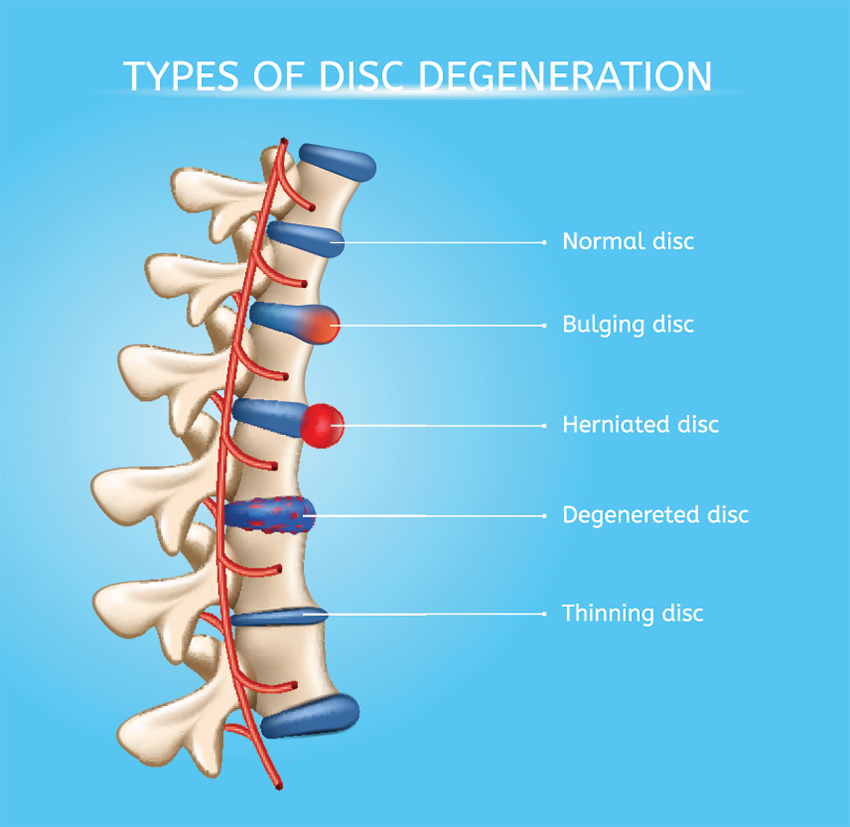

Based on the results, you may be referred to a neurologist, orthopedist, or neurosurgeon for treatment. Your doctor may order imaging studies: X-ray, MRI scan, discogram, myelogram, or CT scan to identify disc problems or other conditions. Next a physical exam is performed to determine the source of the pain and test for any muscle weakness or numbness. Your doctor will take a complete medical history to understand your symptoms, prior injuries, and if lifestyle habits are causing the pain. When you first experience pain, consult your family doctor. People who smoke are at greater risk for disc disease, as are people who work in certain jobs. Most of the time it occurs slowly and does not cause symptoms until middle age. This condition can affect young adults who lead active lifestyles. Various factors contribute to disc degeneration including: genetic, autoimmune, inflammatory, and traumatic. Its not known why some people have pain and others don't. Lifestyle habits such as obesity, smoking, poor posture, and weak muscles strain the discs. In addition to age and injury, arthritis and osteoporosis contribute to disc degeneration. But later in life, your discs will have dried out and stabilized causing less pain. Symptoms of disc disease tend to be more severe between ages 30 to 50. You may feel better if you walk or run rather than sit or stand for too long. If your toes drag the floor when you walk (foot drop), consult your doctor right away.Īctivities such as sitting, bending, or twisting may make your pain worse, while lying down tends to relieve the pain. Weakness in your leg or foot can cause balance and gait problems. Pain may spread to the buttocks or down one or both of your legs (sciatica). Headaches at the back of your head can occur.Ī lumbar degenerative disc may cause low back pain and stiffness. Pinched nerve pain may radiate into the arms and hands. You may also feel numbness or tingling “pins and needles.”Ī cervical degenerative disc may cause a stiff neck along with pain in the neck and shoulders. Pain and stiffness can occur in the neck or low back. These episodes last from a few days to a few months. People commonly report underlying pain that is a nagging annoyance, with occasional flare-ups of intense muscle pain. Some people have no pain, while others may experience intense pain that interferes with daily activities. The symptoms of a degenerative disc vary from person to person. Bone spurs and tears in the annulus may lead to herniated discs, pinched nerves and spinal stenosis. Drawing of a degenerative disc that is dried out and collapsed, reducing the disc space between vertebrae. This over-growth causes the spinal canal to narrow, which can compress the spinal cord and nerves resulting in pain (see Spinal Stenosis).įigure 2. Spinal canal narrows: stressed ligaments and facet joints enlarge as they try to compensate and spread the load over a larger area.Pinched nerves may result in neck, arm, back, or leg pain (sciatica). Excess motion: abnormal rubbing adds stress to the facet joints.Bone spurs grow: without the discs holding apart the vertebrae, they can rub on each other causing abnormal bone growths.Disc gets thinner: due to the loss of water, the discs get thin and the distance between vertebrae begin to collapse.Over time the proteins dry up, and the discs become stiffer. Tiny nerves in the annulus cause discogenic pain with small micro-motions of the disc. The nucleus has inflammatory proteins that can irritate nerves and cause pain. Small tears in annulus: the gel-like nucleus can push through cracks in the disc wall.As you get older it slowly loses water and flexibility, which puts more stress on the disc annulus. Discs dry out and shrink: the disc nucleus is made of about 80% water.Age-related changes to discs include (Fig. Discs have a limited blood supply, so once injured they can’t repair themselves easily. It’s a condition in which your discs lose their flexibility and height to cushion the spine. What is degenerative disc disease?ĭegenerative disc disease (spondylosis) can occur in any area of the spine. Drawing of a normal disc showing the gel-filled nucleus surrounded by annulus rings of cartilage fibers.


 0 kommentar(er)
0 kommentar(er)
